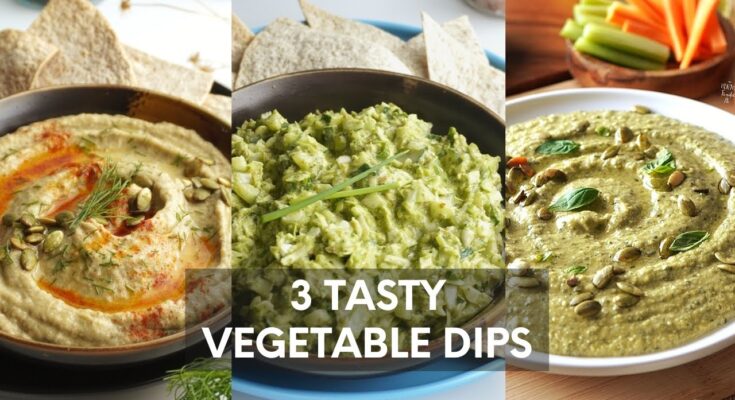Veggie Dip Recipe: Who doesn’t love a good dip? Especially one that’s creamy, full of flavor, and healthy enough to pair with your favorite fresh veggies. Veggie dips are more than just sidekicks at parties—they’re the heroes of healthy snacking. Whether you’re prepping for a casual movie night, a big holiday bash, or just your afternoon munch, a homemade veggie dip can elevate your snack game like nothing else.
Store-bought dips might save you a few minutes, but they often come packed with preservatives, hidden sugars, and a bunch of artificial flavors. On the other hand, making your own allows full control over what goes in—and that’s where the real magic happens. Want it extra garlicky? Go for it. Prefer a little heat with chili flakes? Toss them in. You’re the chef here!
This guide walks you through everything—from what ingredients you need, to how to mix them just right. Let’s get dipping!
Ingredients You’ll Need
The beauty of a veggie dip lies in its versatility. You don’t need to follow one strict recipe—just a basic structure, and from there, the possibilities are endless. Here’s a typical ingredient list to make a classic creamy herb dip, but feel free to tweak it based on what you love:
Base Ingredients:
- 1 cup sour cream (or Greek yogurt for a tangier taste)
- ½ cup mayonnaise (for richness)
- 1 tablespoon lemon juice (or apple cider vinegar)
Flavoring Agents:
- 1 garlic clove, finely minced (or ½ tsp garlic powder)
- 1 teaspoon onion powder
- ½ teaspoon dried dill
- ½ teaspoon parsley (dried or fresh)
- ¼ teaspoon black pepper
- ½ teaspoon salt (or to taste)
- Optional: a pinch of cayenne or smoked paprika for a kick
Extras:
- Chopped chives or scallions
- Fresh spinach, kale, or roasted red peppers for color and nutrients
- Crumbled feta or blue cheese for a salty twist
If you’re going vegan, no worries. Swap the dairy out for cashew cream, coconut yogurt, or plant-based sour cream. The herbs and seasonings do most of the flavor work, so you won’t miss a beat.
Kitchen Tools Required
You don’t need fancy gadgets to whip up a killer veggie dip, but a few basic kitchen tools will make the job quicker and cleaner.
Essential Tools:
- Mixing bowls (preferably medium-sized)
- Whisk or spoon for mixing
- Measuring spoons and cups
- Garlic press (optional but super handy)
Optional Tools for Extra Smoothness:
- Blender or food processor (great for ultra-smooth dips)
- Spatula (for scraping every last bit of dip goodness)
Blenders can especially help when you’re including denser veggies or greens like kale. It helps incorporate everything into a silky blend that still feels fresh.
Step-by-Step Instructions
Let’s dive into the action. Making your own veggie dip takes less than 15 minutes, but letting it chill for an hour (or more) gives it superstar flavor. Here’s how to do it right.
Step 1 – Prepare the Ingredients
Start by gathering everything. The smoother the prep, the faster you’ll be dipping.
- Wash your fresh herbs, pat them dry, and chop them finely.
- If using fresh garlic, mince it finely or use a garlic press.
- Juice your lemon, measure your dairy or non-dairy base, and lay everything out in one place.
This is also a good time to chop your dipping veggies—carrots, celery, bell peppers, cucumbers, snap peas, and even broccoli florets all work great. A colorful platter of fresh veggies alongside your dip makes for a feast for both the eyes and stomach.
Once you’ve got everything ready, it’s time to build the base!
Step 2 – Mix the Base
Your base sets the tone for the entire dip—it’s like the canvas of a painting. Most classic veggie dips use a combo of sour cream and mayo. This duo provides creaminess, tang, and richness that holds the dip together and enhances all the flavors you’ll add later. But if you’re aiming for a healthier or dairy-free option, Greek yogurt, vegan mayo, or even silken tofu blended smooth can do the job just as well.
Start by adding your chosen base into a mixing bowl. For a standard serving, use 1 cup of sour cream and ½ cup of mayo. Whisk these together until smooth and fluffy. This step is all about blending textures and making sure the mixture is lump-free.
Want to punch up the flavor? Add a tablespoon of lemon juice or apple cider vinegar. Not only does it add a bright, tangy edge, but it also helps balance out the richness of the dairy. Stir it in gently and get ready for the fun part—seasoning.
Step 3 – Add Flavor with Herbs and Spices
Here’s where your dip starts to come alive. The right combination of herbs and spices turns a bland bowl of cream into a flavor explosion.
Start with the basics:
- 1 tsp onion powder for that deep savory note
- ½ tsp garlic powder (or use your minced fresh garlic)
- ½ tsp dried dill – a must for that classic ranch-like taste
- ½ tsp parsley or chives for freshness
- ¼ tsp black pepper for a subtle bite
- Salt to taste – usually around ½ tsp, but always taste and adjust
Want to experiment? Add a pinch of cayenne for heat, smoked paprika for depth, or even curry powder for an exotic twist. Don’t shy away from combining fresh herbs like chopped basil or mint if you’re going Mediterranean-style.
Mix all the spices and herbs into your creamy base thoroughly. Stir until everything is fully incorporated and your dip starts looking speckled with flavor.
Herbs can make or break a dip, so if you’re using fresh ones, chop them finely. Nobody wants to bite into a huge leaf of parsley—unless that’s your style, of course.
Step 4 – Blend or Whisk Thoroughly
Now that your base and seasonings are combined, it’s time to bring the whole mixture together into one smooth, unified dip.
If you’re going for a rustic, chunky texture, a good old-fashioned whisk or spoon will do the trick. Mix with purpose—circular motions that fold air into the dip will give you that light, fluffy consistency.
Prefer something ultra-smooth? Throw everything into a food processor or blender. A quick 15-20 second pulse will blend the ingredients perfectly and create a silky, luxurious dip that’s ideal for spreading or scooping.
This is also the moment where you can add any extras:
- Crumbled feta or goat cheese for a salty edge
- A handful of spinach or kale for a green boost
- Roasted red peppers for sweetness and color
Blending these in will infuse the dip with new dimensions, both visually and in taste.
Once you’re happy with the texture, give it a taste. Need more zing? Add lemon. Too bland? Try more salt or herbs. Remember—dips are forgiving. You can almost always fix or enhance them with a little creativity.
Step 5 – Chill and Let Flavors Marinate
You’ve done the hard part, but trust me—this next step is what truly transforms your dip.
Cover the bowl with plastic wrap or transfer the dip to an airtight container. Then place it in the refrigerator for at least 1 hour. This resting time allows the flavors to blend, the herbs to release their oils, and the entire mixture to settle into a cohesive, rich taste.
If you’re in a rush, even 20 minutes of chilling helps. But for best results, overnight is the gold standard. It’s like the difference between a stew right after cooking and the same stew the next day—it just gets better.
Chilling also helps firm up the dip slightly, making it easier to scoop and serve. If you notice any separation after chilling (especially with yogurt-based dips), just give it a quick stir before serving.
And there you have it—the foundation of a perfect veggie dip. But wait, we’re not done yet. Let’s take it up a notch.
Customizing Your Veggie Dip
One of the best things about making your own dip? You can play with the flavor like a chef in a test kitchen. Whether you’re into bold, tangy, cheesy, spicy, or herbal notes, veggie dip is a blank canvas for your creativity.
Add Cheese or Vegan Options
Craving that extra umami kick? Adding cheese to your veggie dip can elevate it instantly. Crumbled feta, grated Parmesan, shredded cheddar, or even soft goat cheese blend beautifully into the base. Each type adds a unique texture and flavor.
- Feta: Salty, tangy, crumbly—perfect for Mediterranean-style dips.
- Goat cheese: Creamy, slightly tart, pairs well with herbs.
- Parmesan: Nutty, sharp, ideal for Italian-inspired versions.
If you’re dairy-free, don’t worry. Nutritional yeast is a fantastic alternative. It delivers a cheesy flavor without any actual cheese. Other great vegan options include:
- Tahini: Offers creaminess and a nutty undertone.
- Cashew cheese: Made by blending soaked cashews with lemon juice and garlic.
- Vegan cream cheese: Gives a thick, luscious texture similar to dairy versions.
Customizing with cheese or its alternatives not only enhances taste but can help complement the veggie dippers you plan to serve.
Spice It Up or Keep It Cool
Some like it hot, others like it mild—luckily, this dip does both. Adjusting the heat level can dramatically change the dip’s personality.
To spice things up:
- Add a few dashes of hot sauce or sriracha.
- Mix in crushed red pepper flakes or a pinch of cayenne.
- Blend in a roasted jalapeño or a bit of chipotle in adobo sauce for smoky heat.
To keep it mellow:
- Stick with classic herbs like dill, chives, and parsley.
- Add cucumber, yogurt, and mint for a tzatziki-style cooling dip.
- Use a bit of honey or agave to balance acidity if needed.
Feel free to split your dip into portions and season each differently. A spicy half for heat lovers, and a cool, mellow version for everyone else. That’s the beauty of DIY dips!
Perfect Veggie Pairings
A dip is only as good as the stuff you scoop it with, right? That’s where your veggie dippers come into play. You want crunchy, colorful, and easy-to-hold pieces that complement the creaminess of the dip.
Best Veggies for Dipping:
- Carrots: Cut into sticks or rounds, they’re sweet and sturdy.
- Cucumbers: Cool, crisp, and hydrating—great with spicy dips.
- Bell peppers: Add color and sweetness; slice into wide strips.
- Celery: Crunchy and slightly bitter, balances rich dips well.
- Broccoli and cauliflower florets: Bite-sized and hearty.
- Cherry tomatoes: Bursty and sweet; ideal for small bites.
- Snap peas and green beans: Mild, fresh, and satisfying.
Want to go fancy? Serve your dip inside a hollowed-out bell pepper or a bread bowl. Arrange your veggies in a rainbow pattern on a platter to make it visually appealing and more inviting.
Serving Ideas and Presentation Tips
Don’t just serve dip—present it. A well-plated veggie dip can steal the show at any gathering. Here’s how to make your dip spread Instagram-worthy:
Presentation Tips:
- Use a shallow bowl or ramekin for the dip—easy to scoop and pretty to look at.
- Garnish with a swirl of olive oil, fresh herbs, or a sprinkle of paprika for color.
- Arrange veggies around the dip in a circular or layered pattern.
- Use contrasting colors: green cucumbers next to red bell peppers, orange carrots beside purple cauliflower.
Hosting a party? Offer multiple dips in small bowls: classic herb dip, spicy chipotle, and a vegan green goddess version. Add pita chips, breadsticks, or even fruit like apple slices or grapes to mix it up.
For kids, make veggie kabobs with colorful veggie chunks on skewers, served with a cup of dip on the side. It’s fun and mess-free!
Storing and Shelf Life
Homemade veggie dip doesn’t last forever—but with the right storage, it can stay fresh for days. After all, no one wants to dip into something that’s gone funky.
Storage Tips:
- Store in an airtight container in the fridge.
- Keep the container small so there’s less air space.
- Stir before serving if it separates slightly (especially yogurt-based dips).
- Don’t double-dip to avoid bacteria.
Shelf Life:
- Dairy-based dips: Best consumed within 4–5 days.
- Vegan dips (with cashew cream or tahini): Can last up to 6–7 days.
- Avoid freezing unless it’s a blended dip (like hummus); freezing may change texture.
Label your container with the date you made it. That way, there’s no guessing if it’s still good when you come back for a snack later in the week.
Common Mistakes to Avoid
Even though making veggie dip seems simple, a few common missteps can turn your flavorful creation into a bland or unappealing mess. Let’s make sure your dip is a winner every time by avoiding these pitfalls:
1. Overseasoning or Underseasoning
Finding the perfect seasoning balance is key. Too much salt or garlic can overpower the dip, while too little can make it taste flat. Always taste as you go—start small and build flavor gradually.
2. Skipping the Chill Time
We get it—you’re hungry! But rushing to serve your dip right after mixing can lead to a less flavorful experience. Letting the dip sit in the fridge for at least an hour allows the flavors to meld beautifully. It’s worth the wait.
3. Using Watery Veggies Without Draining
If you’re adding ingredients like cucumber, spinach, or tomatoes, make sure to squeeze out excess moisture. Water can dilute the dip and ruin the texture. A simple cheesecloth or kitchen towel squeeze does the trick.
4. Overmixing in a Blender
Blenders are great, but overdoing it can turn your dip into soup. Use a few quick pulses and stop once it reaches the desired consistency. You want creamy, not runny.
5. Poor Storage
Leaving your dip uncovered in the fridge or letting it sit at room temperature too long is a recipe for spoilage. Always store it airtight and return it to the fridge within 2 hours of serving.
Avoid these missteps and your dip will always come out party-ready, flavorful, and fresh.
Health Benefits of Veggie Dips
You might think of dips as indulgent snacks, but when made with wholesome ingredients, they can be a surprisingly healthy addition to your diet. Let’s break down why:
1. Rich in Nutrients
Many veggie dips start with yogurt, sour cream, or plant-based alternatives, offering a good source of calcium, protein, and probiotics. Adding fresh herbs boosts antioxidant intake.
2. Supports Better Snacking
Pairing a nutritious dip with raw vegetables encourages healthier snacking. Instead of reaching for chips or sweets, a creamy, savory dip paired with crunchy veggies hits the spot while providing fiber, vitamins, and minerals.
3. Promotes Hydration
Veggies like cucumbers, bell peppers, and celery have high water content. Combined with dips, they become even more appealing and hydrating, especially in hot weather or post-workout meals.
4. Boosts Digestion
Garlic, yogurt, and herbs like mint and dill are known to support gut health. Yogurt dips contain probiotics, while garlic and herbs contain compounds that can reduce inflammation and aid digestion.
5. Aids in Portion Control
A flavorful veggie dip can help you feel full faster. When you’re satisfied with flavor and texture, you’re less likely to overeat. Dips can even encourage picky eaters to consume more vegetables—talk about a win-win.
So next time you whip up a dip, know that you’re doing more than just treating your taste buds—you’re nourishing your body too.
FAQs about Veggie Dip Recipe
1. What is the best base for a veggie dip?
The most popular bases are sour cream, Greek yogurt, or cream cheese. They provide a creamy texture and pair well with herbs and spices.
2. Can I make a dairy-free veggie dip?
Yes! Use dairy-free alternatives like coconut yogurt, almond-based cream cheese, or cashew cream for a vegan version.
3. How long does homemade veggie dip last?
Stored in an airtight container in the refrigerator, homemade veggie dip typically lasts 3–5 days.
4. Can I freeze veggie dip?
Freezing is not recommended, especially for dairy-based dips, as the texture may change once thawed.
5. What vegetables go well with veggie dip?
Carrots, celery, bell peppers, cherry tomatoes, cucumbers, and broccoli florets are classic favorites.
6. Can I make the dip ahead of time?
Absolutely! In fact, veggie dip tastes better when made a few hours ahead to let the flavors blend well.
7. What herbs and seasonings work best?
Dill, garlic powder, onion powder, chives, parsley, and a pinch of salt and pepper elevate the flavor.
8. Is veggie dip healthy?
It depends on the ingredients. Using Greek yogurt or low-fat sour cream and adding fresh herbs makes it a healthier choice.
9. Can I add spice to my veggie dip?
Yes! Add a dash of cayenne pepper, paprika, or chopped jalapeños for a spicy kick.
10. What are some fun variations of veggie dip?
Try adding spinach, roasted red peppers, or caramelized onions for unique flavor twists.
Conclusion
There you have it—a complete, step-by-step guide to making your very own homemade veggie dip. Whether you’re going for a cool and creamy herb blend or spicing things up with bold flavors and cheese, veggie dip is the perfect partner to fresh, crunchy vegetables.
The beauty lies in its flexibility. With just a few base ingredients, you can create something delicious, healthy, and totally tailored to your taste. It’s ideal for parties, afternoon snacks, or even as a meal starter.
So go ahead, get creative with herbs, add some heat if you’re feeling bold, or sneak in some greens for added nutrition. And remember, homemade always tastes better—especially when it’s made with love.
Now grab those veggies, dip in, and enjoy every flavorful bite!



